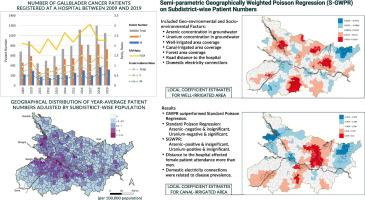当前位置:
X-MOL 学术
›
Sci. Total Environ.
›
论文详情
Our official English website, www.x-mol.net, welcomes your feedback! (Note: you will need to create a separate account there.)
Geo-spatial epidemiology of gallbladder cancer in Bihar, India
Science of the Total Environment ( IF 9.8 ) Pub Date : 2024-04-13 , DOI: 10.1016/j.scitotenv.2024.172460 Maiko Sakamoto , Arun Kumar , Deokrishna Kumar Choudhary , Akhouri Bishwapriya , Ashok Ghosh
Science of the Total Environment ( IF 9.8 ) Pub Date : 2024-04-13 , DOI: 10.1016/j.scitotenv.2024.172460 Maiko Sakamoto , Arun Kumar , Deokrishna Kumar Choudhary , Akhouri Bishwapriya , Ashok Ghosh

|
Recently, a substantial increase in gallbladder cancer (GBC) cases has been reported in Bihar, India. The region's groundwater can naturally contain harmful concentrations of arsenic, which appears to be epidemiologically linked to the unusually high incidence. However, the root causes remain largely unexplored. Recent findings of uranium in the state's groundwater may also have associations. This study investigates the geo-spatial epidemiology of GBC in Bihar, India—with a focus on the correlation between environmental carcinogens, particularly arsenic and uranium in groundwater, and the incidence of GBC. Utilizing data from 8460 GBC patients' registration records over an 11-year period at a single health center, the research employs Semi-parametric Geographically Weighted Poisson Regression (S-GWPR) to account for non-stationarity associations and explores significant factors contributing to GBC prevalence at a subdistrict level. The S-GWPR model outperformed the standard Poisson regression model. The estimates suggest that arsenic and uranium concentrations in groundwater did not present significant associations; however, this could be due to the lower resolution of this data at the district level, necessitating higher resolution data for accurate estimates. Other socio-environmental factors included demonstrated significant regional heterogeneity in their association with GBC prevalence. Notably, each 1 % increase in the coverage of well- and canal-irrigated areas is associated with a maximum of 3.0 % and 5.2 % rise in the GBC incidence rate, respectively, likely attributable to carcinogen exposure from irrigation water. Moreover, distance to the health center and domestic electricity connections appear to influence the number of reported GBC cases. The latter suggests that access to electricity might have facilitated the use of groundwater pumps—increasing exposure to carcinogens. The results underscore the necessity for targeted health policies and interventions based on fine-resolution spatial analysis, as well as ongoing environmental monitoring and research to better understand the multifaceted risk factors contributing to GBC.
中文翻译:

印度比哈尔邦胆囊癌的地理空间流行病学
最近,印度比哈尔邦报告胆囊癌(GBC)病例大幅增加。该地区的地下水自然含有有害浓度的砷,这似乎与异常高的发病率有关。然而,其根本原因在很大程度上仍未被探索。最近在该州地下水中发现的铀也可能存在关联。本研究调查了印度比哈尔邦 GBC 的地理空间流行病学,重点关注环境致癌物(特别是地下水中的砷和铀)与 GBC 发病率之间的相关性。该研究利用单个健康中心 11 年期间 8460 名 GBC 患者的登记记录数据,采用半参数地理加权泊松回归 (S-GWPR) 来解释非平稳性关联,并探讨导致 GBC 的重要因素街道一级的患病率。 S-GWPR 模型优于标准泊松回归模型。估计表明地下水中的砷和铀浓度没有呈现显着的关联;然而,这可能是由于地区一级的数据分辨率较低,需要更高分辨率的数据才能进行准确估计。其他社会环境因素与 GBC 患病率的关联显示出显着的区域异质性。值得注意的是,井灌区和运河灌溉区的覆盖率每增加 1%,GBC 发病率分别最多增加 3.0% 和 5.2%,这可能归因于灌溉水中的致癌物质暴露。此外,距医疗中心的距离和家庭电力连接似乎也会影响报告的 GBC 病例数量。后者表明,电力的使用可能促进了地下水泵的使用——增加了致癌物的暴露。结果强调了基于精细分辨率空间分析以及持续的环境监测和研究的有针对性的卫生政策和干预措施的必要性,以更好地了解导致 GBC 的多方面风险因素。
更新日期:2024-04-13
中文翻译:

印度比哈尔邦胆囊癌的地理空间流行病学
最近,印度比哈尔邦报告胆囊癌(GBC)病例大幅增加。该地区的地下水自然含有有害浓度的砷,这似乎与异常高的发病率有关。然而,其根本原因在很大程度上仍未被探索。最近在该州地下水中发现的铀也可能存在关联。本研究调查了印度比哈尔邦 GBC 的地理空间流行病学,重点关注环境致癌物(特别是地下水中的砷和铀)与 GBC 发病率之间的相关性。该研究利用单个健康中心 11 年期间 8460 名 GBC 患者的登记记录数据,采用半参数地理加权泊松回归 (S-GWPR) 来解释非平稳性关联,并探讨导致 GBC 的重要因素街道一级的患病率。 S-GWPR 模型优于标准泊松回归模型。估计表明地下水中的砷和铀浓度没有呈现显着的关联;然而,这可能是由于地区一级的数据分辨率较低,需要更高分辨率的数据才能进行准确估计。其他社会环境因素与 GBC 患病率的关联显示出显着的区域异质性。值得注意的是,井灌区和运河灌溉区的覆盖率每增加 1%,GBC 发病率分别最多增加 3.0% 和 5.2%,这可能归因于灌溉水中的致癌物质暴露。此外,距医疗中心的距离和家庭电力连接似乎也会影响报告的 GBC 病例数量。后者表明,电力的使用可能促进了地下水泵的使用——增加了致癌物的暴露。结果强调了基于精细分辨率空间分析以及持续的环境监测和研究的有针对性的卫生政策和干预措施的必要性,以更好地了解导致 GBC 的多方面风险因素。



























 京公网安备 11010802027423号
京公网安备 11010802027423号